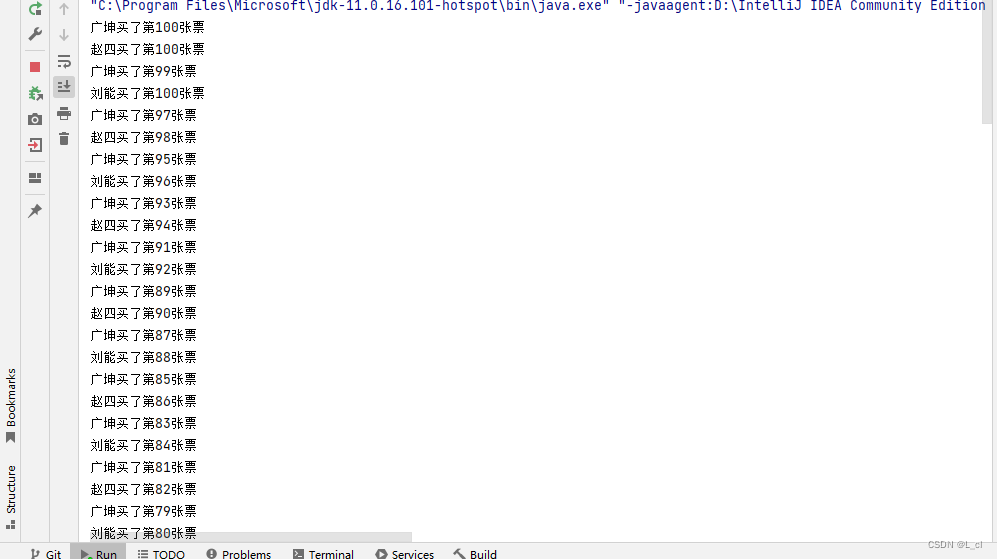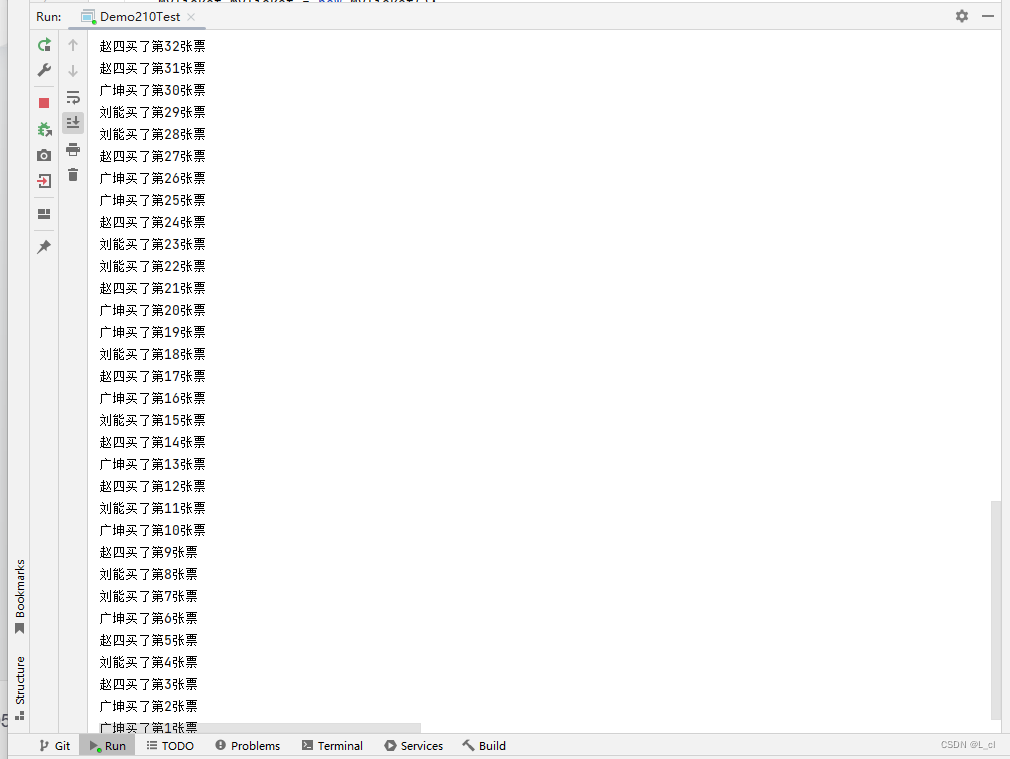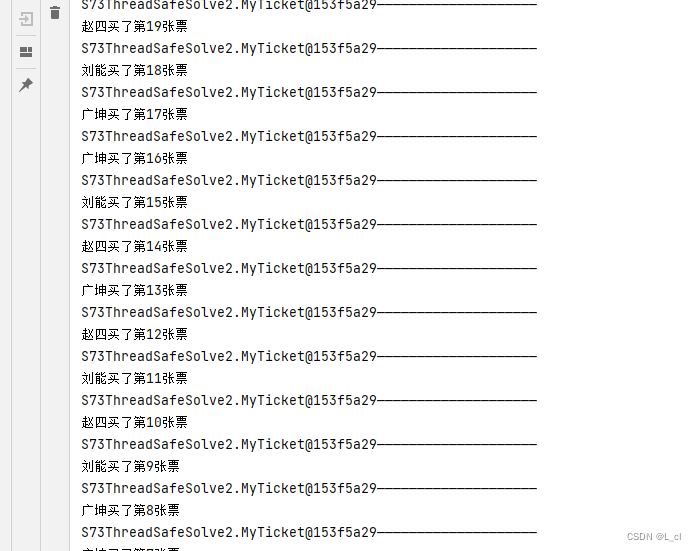逐渐成为一个情绪稳定且安静成长的人
——24.5.24
线程安全
什么时候发生?
当多个线程访问同一个资源时,导致了数据有问题,出现并发问题,数据不能及时更新,导致数据发生错误,出现线程安全问题
多线程安全问题示例
package S71ThreadSafe;public class MyTicket implements Runnable{// 定义100章票int ticket = 100;@Overridepublic void run(){while(true){if(ticket>0){System.out.println(Thread.currentThread().getName()+"买了第"+ticket+"张票");ticket--;}}} }package S71ThreadSafe;public class Demo210Test {public static void main(String[] args) {// new一次,分别传递到三个线程对象中去MyTicket myTicket = new MyTicket();Thread th1= new Thread(myTicket, "赵四");Thread th2= new Thread(myTicket, "刘能");Thread th3= new Thread(myTicket, "广坤");th1.start();th2.start();th3.start();} }
解决线程安全问题方式一:同步代码块
synchronized代码块 == 上锁 可以解决线程安全问题,不保证线程顺序
1.格式:
synchronized(任意接收对象){
线程要执行的语句;
}
2.任意对象:
就是我们的锁对象
3.执行:
一个线程拿到锁之后,会进入到同步代码块中执行,在此期间,其他线程拿不到锁,就进不去同步代码块。需要在同步代码块外面等待排队,需要等待执行的线程执行完毕,出了同步代码块,相当于释放锁了,等待的线程才能抢到锁,才能进入到同步代码块中执行,上的锁必须是同一个锁对象,同一把锁
package S71ThreadSafe;import java.util.Scanner;public class MyTicket implements Runnable{// 定义100章票int ticket = 100;// 任意new一个对象Object obj = new Object();Scanner sc = new Scanner(System.in);@Overridepublic void run(){while(true){synchronized (sc) {if (ticket > 0) {System.out.println(Thread.currentThread().getName() + "买了第" + ticket + "张票");ticket--;}}}} }package S71ThreadSafe;public class Demo210Test {public static void main(String[] args) {// new一次,分别传递到三个线程对象中去MyTicket myTicket = new MyTicket();Thread th1= new Thread(myTicket, "赵四");Thread th2= new Thread(myTicket, "刘能");Thread th3= new Thread(myTicket, "广坤");th1.start();th2.start();th3.start();} }
解决线程安全问题方式二:同步方法
1.普通同步方法_非静态
在普通方法内用一个同步代码块
① 格式:
修饰符 synchronized 返回值类型 方法名(参数){
方法体
return 结果}
② 默认锁:
this
package S73ThreadSafeSolve2;public class Demo212Test {public static void main(String[] args) {// new一次,分别传递到三个线程对象中去MyTicket myTicket = new MyTicket();System.out.println(myTicket);Thread th1= new Thread(myTicket, "赵四");Thread th2= new Thread(myTicket, "刘能");Thread th3= new Thread(myTicket, "广坤");th1.start();th2.start();th3.start();} }package S73ThreadSafeSolve2;import java.util.Scanner;public class MyTicket implements Runnable{// 定义100章票int ticket = 100;Scanner sc = new Scanner(System.in);@Overridepublic void run(){while(true){try{Thread.sleep(100L);} catch (InterruptedException e) {throw new RuntimeException(e);}// 调用同步方法// method01();method02();}}// 定义一个同步方法public synchronized void method01(){if (ticket > 0) {System.out.println(Thread.currentThread().getName() + "买了第" + ticket + "张票");ticket--;}}// 在普通方法内用一个同步代码块public void method02(){synchronized (this){System.out.println(this+"————————————————————");if (ticket>0){System.out.println(Thread.currentThread().getName() + "买了第" + ticket + "张票");ticket--;}}}}只new了一次对象
2.静态同步方法
① 格式
修饰符 static synchronized 返回值类型 方法名(参数){
方法体
return 结果}
② 默认锁
class对象
package S74ThreadSafeSolve3;import java.util.Scanner;public class MyTicket implements Runnable{// 定义100章票static int ticket = 100;Scanner sc = new Scanner(System.in);@Overridepublic void run(){while(true){try{Thread.sleep(100L);} catch (InterruptedException e) {throw new RuntimeException(e);}// 调用同步方法method02();}}// 在普通方法内用一个同步代码块public static void method02(){synchronized (MyTicket.class){if (ticket>0){System.out.println(Thread.currentThread().getName() + "买了第" + ticket + "张票");ticket--;}}}}package S74ThreadSafeSolve3;public class Demo213Test {public static void main(String[] args) {// new一次,分别传递到三个线程对象中去MyTicket myTicket = new MyTicket();System.out.println(myTicket);Thread th1= new Thread(myTicket, "赵四");Thread th2= new Thread(myTicket, "刘能");Thread th3= new Thread(myTicket, "广坤");th1.start();th2.start();th3.start();} }StringBuider是线程不安全的,StringBuffer加了死锁是线程安全,线程同步的






—— 内部类)











)



